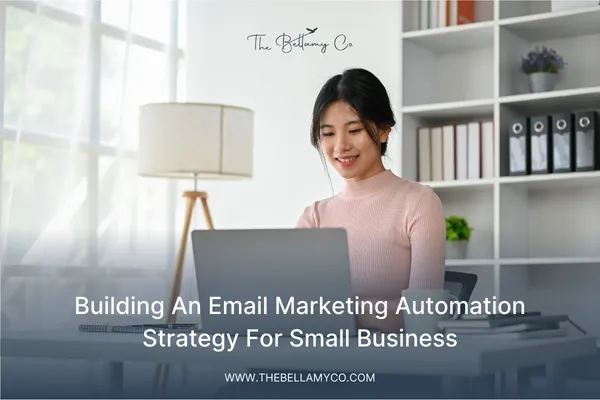
Email Marketing Automation Strategy For Small Business
Building An Email Marketing Automation Strategy For Small Business
Are you satisfied with how your email marketing is performing? Or do you wish you could do something to make it more efficient and effective?
Small businesses are often put under a lot of pressure regarding marketing. Every campaign costs a hefty amount of time and resources. This leaves little room for error and makes business owners crave a miraculous tool that can create more positive results.
Luckily, technology has come a long way. Now, we have marketing tools to make what was once a bizarre wish come true. With automation, small businesses can create personalized campaigns in under a day, giving ten times the engagement, conversions, and revenue old methods can produce.
However, just as a pen cannot write by itself, automation tools are worthless without the right strategy. In this blog, we'll teach you how you can build an effective email marketing automation strategy for your small business so you can increase engagement, boost sales, and save valuable time—without the stress.

TL;DR? Here's what's inside...
Building An Email Marketing Automation Strategy For Small Business
What is a marketing automatitegy?
Benefits of email automation strategy
How do you automate email marketing?
Email marketing automation tools and platform
Our top choice for small businesses? Elevate360.
Email marketing automation strategy examples
Best practices when building an email marketing automation strategy
Solid strategy + right tool = successful email marketing automation
What is a marketing automatitegy?
Marketing automation strategy is what businesses call their game plan for using automation tools effectively. It is a structured approach to automating marketing tasks like email campaigns, customer follow-ups, and lead nurturing to drive better engagement and conversions.
Strategy is essential because automation alone won’t guarantee success—without a clear plan, businesses risk sending irrelevant messages, losing engagement, and wasting resources. A strong strategy ensures that every automated action serves a purpose, aligns with business goals, and delivers real results.
Benefits of email automation strategy
Email marketing campaigns are one of the best places to start with your strategy. But why?
Targeted messaging
People inside your email list are people who opted to hear from you! Based on their previous interaction with your business, you know their likes, dislikes, and birthdays. You can use this to your advantage and craft campaigns based on their specific interests so your marketing efforts don't go to waste.
Save time and increase efficiency
Automation was made to solve the lack of time and low productivity. Automating welcome emails, nurture campaigns, product launches, and even follow-ups eliminates repetitive tasks, giving you more time to spend on important tasks.
Make smart choices with data
Automation shows you what’s working and what’s not, like your open, click, and conversion rates. You don’t have to guess what your audience likes. Instead, you can group people based on their interests or behavior, tweak your emails to match their needs, and make smarter marketing decisions that bring results.
An effective email marketing automation strategy is about working smarter and making every email count without the hassle of manual work. Read more about email automation in “The Ins and Outs of Email Automation for Small Businesses.”

How do you automate email marketing?
Now, the question is, how do you automate email marketing? Some marketers will tell you to invest in a high-end CRM, build complex funnels, and run A/B tests on everything. While that is true, it's not always realistic for small businesses.
Thus, we recommend starting with a simple yet scalable system that fits your needs and budget. A way for every business—big or small—to set up automated emails that nurture leads, engage customers, and drive sales without requiring an entire marketing team.
Here’s how:
Choose the right marketing automation software
Hundreds of automation software are available; choosing one is enough to make your head spin. Our greatest tip for you is to choose one that meets your needs as a small business but can grow with you once you start to scale!
It's hard enough to set your footing and even harder to switch platforms once you’ve built everything out. So, it’s better to start with a tool that’s flexible, user-friendly, and built for long-term growth. See the next section, where we go deeper into this detail.
Segment your email list
Not all subscribers are the same. Group them based on interests, behavior, or purchase history so you can craft and send email content that matters to them.
A helpful way to segment your list is by mapping your customer journey. Looking at where they are now and when they will likely take action tells you a lot! You can identify who needs a welcome email, who’s ready for a special offer, and who might need a little nudge to re-engage.
Create trigger-based workflows
A workflow is a series of automated emails that guide your subscribers through a specific journey. At the same time, a trigger is an action that sets it in motion—like signing up, abandoning a cart, or making a purchase.
Setting up trigger-based emails ensures that your audience gets the right message at the right time without you lifting a finger. These workflows help nurture leads, recover lost sales, and keep customers engaged, ultimately creating a successful email marketing automation strategy that works 24/7 to grow your business.
Track, test, and improve
Email automation is a long game. You need to monitor key metrics like open rates, click rates, and conversion rates after sending to see what’s working and what’s not.
If your emails aren’t getting opened, try adjusting your subject lines or send times. If people open but don’t click, tweak your call-to-action (CTA) or email design to make it more engaging. Regularly testing and optimizing ensures your emails keep performing—and that your audience stays interested and responsive.

Email marketing automation tools and platform
The best email marketing automation strategy uses the right marketing platform. An email marketing platform is the foundation of your plan. If it breaks, your whole strategy can fall apart or won't get executed at all. What are the considerations when choosing the right platform?
Capabilities – Can it segment your audience? Does it have automation workflows to nurture leads and convert customers effortlessly?
Ability to scale – Can you upgrade to a bigger plan without losing data, disrupting workflows, or breaking the bank?
Cost – Does it fit your budget while offering the features you need?
Beginner-Friendly – Most small business owners don’t have a dedicated tech team. You need a platform that’s easy to use, even if you’re juggling a hundred other things.
Support – Do they offer reliable (keyword is RELIABLE) customer support when you need it? Because tech hiccups happen, and you don’t have time to wait days for a fix.
Our top choice for small businesses? Elevate360.
Elevate360 is an all-in-one marketing and operations platform designed to help small businesses automate, optimize, and scale without the usual tech headaches.
Built-in CRM – Keep all your customer interactions in one place, track leads, and personalize your emails for higher engagement and conversions.
Seamless automation – Set up trigger-based workflows that send the right emails at the right time—from welcome sequences to abandoned cart recovery.
Advanced lead tracking – Know exactly who’s opening, clicking, and converting so you can refine your strategy and boost ROI.
Scalable & budget-friendly – Whether you're just starting or growing fast, Elevate360 grows with you without breaking the bank.
User-friendly interface – No tech background? No problem. Elevate360 is built for busy entrepreneurs who need powerful automation without a steep learning curve.
With Elevate360, you’re building relationships, increasing sales, and creating a marketing system that works for you 24/7.

Email marketing automation strategy examples
When and where can you use your strategies? Here are email marketing automation strategy examples that small businesses in different industries can use:
E-commerce: Abandoned Cart Recovery – When someone leaves items in their cart, send a series of reminders to bring them back and complete their purchase.
Service-Based Business: Lead Nurturing Funnel – Someone downloaded your free guide? Follow up with educational emails, testimonials, and a limited-time offer to turn them into paying clients.
Coaching/Consulting: Webinar Follow-Up – After a webinar, automatically send a replay, share key takeaways, and offer a special deal to attendees to keep them engaged.
Local Business: Appointment Reminders – Reduce no-shows by sending automated confirmations, reminders, and post-visit follow-ups to encourage repeat business.

Best practices when building an email marketing automation strategy
When building your email marketing automation strategy, focus on creating valuable, personal experiences, not just sending emails for the sake of it. These best practices will help you engage your audience, boost conversions, and make every message count.
Keep it personal – Use subscriber names, segment your list, and craft messages that feel like a one-on-one conversation, not a generic blast.
Test and optimize – Always track open rates, click rates, and conversions. If something isn’t working, tweak it—change subject lines, adjust timing, or refine your call to action.
Stop sending annoying messages (SPAM) – Just because you can automate emails doesn’t mean you should bombard people’s inboxes. Focus on quality over quantity.
Have a clear goal – Every email should have a purpose. Are you driving sales? Building trust? Growing engagement? Make sure each email serves a specific role in your strategy.
Use the right tools – Automation is only as good as your platform. Choose one that fits your needs, is easy to use, and grows with your business.

Solid strategy + right tool = successful email marketing automation
A strong email marketing automation strategy and the right platform can transform your campaigns from hit-or-miss to consistently high-performing. Automation doesn’t just save time—it increases engagement, boosts conversions, and ensures your message reaches the right people at the right time.
Whether you're starting from scratch or refining what you have, we’ve got you. Book a discovery call, and create an email marketing strategy that works for you.





